This sample sociology research paper on Quality of Life features: 5800 words (approx. 19 pages) and a bibliography with 37 sources. Browse other research paper examples for more inspiration. If you need a thorough research paper written according to all the academic standards, you can always turn to our experienced writers for help. This is how your paper can get an A! Feel free to contact our custom writing service for professional assistance. We offer high-quality assignments for reasonable rates.
As a fairly new interdisciplinary field of inquiry, the quality-of-life research has benefited greatly from the discipline of sociology. The field consists of five overlapping traditions: (1) social indicators research, (2) happiness studies, (3) gerontology of successful aging, (4) psychology of well-being, and (5) health-related quality-of-life research. The efforts of sociologists are particularly prominent in the first two of these traditions. Quality of life is also a major issue in the fields of the sociology of work and the sociology of the family.
Academic Writing, Editing, Proofreading, And Problem Solving Services
Get 10% OFF with 24START discount code
Quality of life has always been a topic of interest in philosophy, where quality of life or the good life is viewed as a virtuous life. The philosophical approach is speculative and tends to be based on the philosopher’s personal experiences in life. In the late twentieth century, however, quality of life became a topic of interest in the social sciences. Social scientists deal in a more empirical way with the subject and systematically gather data on the experiences of other people. In 1995, social scientific quality-of-life research became institutionalized with the founding of the International Society for Quality of Life Studies.
The theme of quality of life developed almost simultaneously in several fields of the social sciences. In sociology, quality of life was often an implicit theme in sociographic studies, such as the portraits of rural life in the United States conducted by Ogburn (1946). Quality of life became the main issue in the “social indicators research” that emerged in the 1960s as a reaction against the domination of economic indicators in the policy process. Initially, the emphasis was on “objective” indicators of well-being, such as poverty, sickness, and suicide; subjective indicators were added during the 1970s.
Landmark books in the latter tradition are Social Indicators of Well-Being: Americans’ Perceptions of Life Quality by Andrews and Withey (1976) and The Quality of American Life: Perceptions, Evaluations and Satisfactions by Campbell, Converse, and Rodgers (1981). Perceived quality of life is now a central issue in social reports in most developed countries, and items on that matter are standard in periodical social surveys. Quality of life has also become an area of interest within the sociology of work, the sociology of housing, and family sociology (Ferriss 2004; Schuessler and Fisher 1985).
In psychology, the first quality-of-life studies were conducted as a part of research into “successful aging.” A typical book of this kind is Personal Adjustment in Old Age by Cavan et al. (1949). In the 1960s, the topic also appeared in studies of mental health, such as Americans View Their Mental Health: A Nationwide Interview Survey by Gurin, Veroff, and Feld (1960) and the groundbreaking crossnational study on The Pattern of Human Concerns by Cantril (1965). Subjective quality of life is now a common issue in psychological research and is often referred to as “subjective well-being” (Diener et al. 1999).
In the 1980s, quality-of-life issues also began to appear in medical research with a focus on patient perceptions of their condition. Typically measured using standard questionnaires such as the Lancaster Quality-of-Life Inventory developed by Lehman (1988), this area of inquiry has focused on “health-related quality of life” and “patient-reported outcomes.” Other medically related quality-of-life studies include residential care (e.g., Clark and Bowling 1990) and handicapped persons (e.g., Schalock 1997).
In the 1990s, quality of life also became an issue in economy. An early analyst in this area was Bernard VanPraag, who summarized much of his work in Happiness Quantified: A Satisfaction Calculus Approach (2004). Another recent account is Happiness and Economics by Bruno Frey and Alois Stutzer (2002).
Social Roots
Quality-of-life research has its roots in several social developments. One such development is the rise in the material standard of living and a concomitant reduction in the occurrence of famine and physical illness. The more humans are free of these ills, the less evident ways for further improvement become, and hence scientific research on the matter becomes more in demand. Interest in quality of life was also stirred by the rise of individualism. The more choices are available, the more interested people become in quality-of-life issues and alternative ways of living. Ideologically, this orientation is manifested in a revival of utilitarian moral philosophy, in which happiness is the central goal (Bentham 1789).
When the postwar economic boom of the 1960s was followed by disenchantment with economic growth, a common slogan of that time was “more well-being rather than more wealth,” and this raised questions of what wellbeing actually is and how it can be furthered. This period of time also witnessed disenchantment with medical technology and a related call for more quality of life rather than mere extension of life. Much of this criticism was voiced by the patient organizations that developed around this time. Health-related quality-of-life research was also furthered by the movement toward “evidence-based” treatment in healthcare that began to come into force during the 1980s. Quality of life was soon seen as a relevant side effect of cure and as a major outcome of care.
Consequently, quality of life became one of the indicators in systematic research into the effects of drugs and treatment protocols.
Concepts of Quality of Life
All social science deals with quality of life in some way. Sociological subjects such as income, power, and prestige can be seen as qualities, and this is also true for psychological subjects such as intelligence and mental health. The crux of quality-of-life research is its inclusiveness; quality-of-life research is not about specific qualities of life but about overall quality. The concept is typically used to strike a balance and designate the desired overall outcome of policies and programs (Schuessler and Fisher 1985:129).
In practice, the term quality of life is used for different notions of the good life. For the most part, quality of life denotes bunches of qualities of life, bunches that can be ordered on the basis of two distinctions. The first distinction is between opportunities for a good life and the outcomes of life. This distinction is quite common in the field of public health research. Preconditions for good health, such as adequate nutrition and professional care, are seldom mixed up with health itself. A second difference is between external and inner qualities. In the first case, the quality is in the environment; in the latter, it is in the individual. This distinction is also quite common in public health. External pathogens are distinguished from inner afflictions. The combination of these two dichotomies yields a fourfold matrix, as shown in Scheme 1.
In the upper half of the scheme, we see next to the outer opportunities in one’s environment, the inner capacities required to exploit these. The environmental conditions can be denoted by the term livability and the personal capacities by the term life ability. This difference is not new. In sociology, the distinction between “social capital” and “psychological capital” is sometimes used in this context, and in the psychology of stress the difference is labeled negatively in terms of “burden” and “bearing power.”
The lower half of the scheme is about the quality of life with respect to its outcomes. These outcomes can be judged by their value for one’s environment and by their value for oneself. The external worth of a life is denoted by the term utility of life, the inner valuation of which is called appreciation of life.
Livability of the Environment
The top left quadrant denotes the meaning of good living conditions, or “livability.” One can also speak of the “habitability” of an environment, though that term is also used for the quality of housing (Veenhoven 1996:7–9). Ecologists view livability in the natural environment and describe it in terms of pollution, global warming, and degradation of nature. Currently, livability is typically associated with environmental preservation. On the other hand, city planners see livability in the built environment and associate it with sewerage systems, traffic jams, and ghetto formation. Here, the good life is seen as a fruit of human intervention. In public health, all this is referred to as a “sane” environment.
Society is central in the sociological view. Firstly, livability is associated with the quality of society as a whole. Classic concepts of the “good society” stress material welfare and social equality, sometimes equating the concept more or less with the welfare state. Currently, communitarians emphasize close networks, strong norms, and active voluntary associations; the reverse of this livability concept is “social fragmentation.” Second, livability is seen in one’s position in society. For a long time, the emphasis was on the “underclass,” but currently, attention is shifting to “social exclusion.” In the latter view, quality of life is full participation in society.
Life Ability of the Person
The concept of “life ability” denotes how well people are equipped to cope with the problems of life. The most common depiction of this aspect of quality of life is the absence of functional defects. This is “health” in the limited sense, sometimes referred to as “negative health.” In this context, doctors focus on unimpaired functioning of the body, while psychologists stress the absence of mental defects. This use of words presupposes a “normal” level of functioning. Good quality of life is the body and mind working as designed. This is the common meaning used in curative care.
Next to absence of disease is the excellence of function, or “positive health,” which is associated with energy and resilience. Psychological concepts of positive mental health also involve autonomy, reality control, creativity, and inner synergy of traits and strivings. This broader definition is the favorite of training professions and is central to the “positive psychology” movement.
Utility of Life
The utility of life represents the notion that a good life must be good for something more than itself. When evaluating the external effects of a life, one can consider the utility of life functionality for the environment. In this context, doctors stress how essential a patient’s life is to his or her intimates. At a higher level, quality of life is seen in contributions to society, the contributions an individual can make to human culture. Moralists see quality in the preservation of the moral order and would deem the life of a saint to be better than that of a sinner. In this vein, the quality of a life is also linked to effects on the ecosystem. Ecologists see more quality in a life lived in a “sustainable” manner than in the life of a polluter. Gerson (1976:795) calls this the “transcendentalist” conception of quality of life.
Enjoyment of Life
The final outcome of life for the individual is the subjective appreciation of life. This is the quality of life in the eye of the beholder, commonly referred to by terms such as subjective well-being, life satisfaction, and happiness in a limited sense of the word.
Humans are capable of evaluating their life in different ways. Like other higher animals, we have an ability to appraise our situation affectively. We feel good or bad about particular things and our mood level signals overall adaptation. These affective appraisals are automatic, but unlike other animals, humans can reflect on this experience. Humans also have a sense of how they have felt in the past. Humans can judge life cognitively by comparing their experience with notions of how it should be.
Measures of Quality of Life
Quality-of-life research is primarily about measurement. Hence, the field can be aptly described by the measures used, of which there are many. In the following sections, examples of measures used in quality-of-life research are presented. The substantive dimensions these measures are thought to represent will be brought to light using the Scheme 1 classification.
Scheme 1

Meanings in Multidimensional Measures of Quality of Life
Most of these measures are multidimensional and assess different qualities of life, which are aggregated in one “quality-of-life score.” Often, the different qualities are also presented separately in a “quality-of-life profile.” Multidimensional measures figure in medical quality-oflife research, gerontological research on “successful aging,” psychological “well-being” research, sociologically oriented research on individual “welfare,” and comparative studies on quality of life in nations.
Example of a Medical Quality-of-Life Index
One of the most common measures used in healthrelated quality-of-life research is the SF-36 Health Survey (Ware 1996). It is a questionnaire on topics on physical limitations in daily chores (10 items), physical limitations to work performance (4 items), bodily pain (2 items), perceived general health (6 items), vitality (4 items), physical and/or emotional limitations to social functioning (2 items), emotional limitations to work performance (3 items), self-characterizations as nervous (1 item), and recent enjoyment of life (4 items). Scheme 2 shows how these topics fit the above classification of qualities of life. Most elements of this scale refer to performance potential and belong in the life-ability quadrant top right. This is not surprising, since the scale is aimed explicitly at health. Still, some of the items concern outcomes rather than potency, in particular the items on recent enjoyment of life (last on the list). As a proper health measure, the SF-36 does not involve outer qualities. So the left quadrants in Scheme 2 remain empty.
Scheme 2
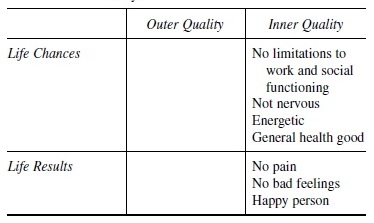
Several other medical measures of quality of life involve items about environmental conditions that belong in the livability quadrant. For instance, the Quality of Life Interview Schedule by Ouelette-Kuntz (1990) involves items such as availability of services for handicapped persons. In this supply-centered measure of the good life, life is better the more services are offered and the more greedily they are used. Likewise, the quality-of-life index for cancer patients (Spitzer et al. 1981) lists support by family and friends as a quality criterion. Some medical indexes also include outer effects that belong to the utility quadrant. Some typical items are continuation of work tasks and support provided to intimates and fellow patients.
Example of a Sociological Welfare Index
Similar indexes have been developed in sociology, mostly in the context of marketing research for the welfare state. One of the first attempts to chart quality of life in a general population was the made in the Scandinavian study of comparative welfare under the direction of Erik Allardt (1976). Welfare is measured using the following criteria: income, housing, political support, social relations, being irreplaceable, doing interesting things, health, education, and life satisfaction. Allardt classified these indicators using his, now classic, distinction between “having” (h), “loving” (l), and “being” (b). These indicators can also be ordered in the fourfold matrix shown in Scheme 3. Most of the scale items belong in the top left quadrant because they concern preconditions for a good life rather than good living as such and because these chances are in the environment rather than in the individual. This is the case with income, housing, political support, and social relations. Two further items also denote chances, but they are internal capabilities. These are the health factor and the level of education. These items are placed in the top right quadrant of personal life ability. The item “being irreplaceable” belongs in the utility bottom left quadrant. It denotes a value of life to others. The last two items belong in the enjoyment bottom right quadrant. “Doing interesting things” denotes appreciation of an aspect of life, while life satisfaction concerns appreciation of life as a whole.
Scheme 3
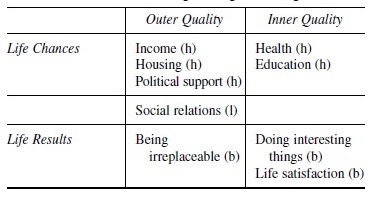
Example of an Index of Quality of Life in Nations
In addition to the measures for comparing quality of life within nations, there are also multidimensional measures for comparing quality of life across nations. These measures are typically meant as an alternative to the common economic metric for quality of life—that is, gross national product per head. They all offer something more but differ in the mix of additions. The most commonly used indicator in this field is the Human Development Index (HDI). This index was developed for the United Nations Development Program (UNDP), which describes the progress in all countries of the world in its annual Human Development Reports (UNDP 1990). The HDI is the major yardstick used in these reports. The basic variant of this measure involves three items: (1) material wealth, measured by buying power per head; (2) education, as measured by literacy and schooling; and (3) life expectancy at birth. Later variants of the HDI involve further items, such as gender equality, measured using the Gender Empowerment Index, which involves male-female ratios in literacy, school enrollment, and income. In a theoretical account of this measure, the UNDP states that the focus should be on how development enlarges people’s choice and, thereby, their chances for leading long, healthy, and creative lives (p. 9).
As shown in Scheme 4, this index covers three meanings. First, it is about living conditions: in the basic index material, affluence in society and in the variants, the degree of social equality. These items belong in the top left quadrant. Second, the HDI includes average educational level, which belongs in the top right quadrant. The item “life expectancy” is an outcome variable and belongs right below. The bottom left quadrant remains empty since the UNDP’s measure of development does not involve indicators of utility of life.
Scheme 4
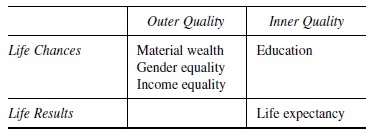
Extended variants in this family provide more illustration. For instance, Naroll’s (1984:73) Quality-of-Life Index includes contributions to science by the country, which fits the utility lower left quadrant. This index also includes mental health, which belongs in the life-ability quadrant, top right and suicide, which belongs in the bottom right quadrant.
Strengths and Weaknesses
The power of these indexes is that they summarize the various qualities of life in one number, thereby allowing comparison with others and monitoring over time. Since most of these measures consist of subindexes, they also provide an overview of strong and weak points. Further, these indexes have public appeal; they list things that are typically valued.
Yet there are also weaknesses in this multidimensional measurement approach. One such limitation is that the lists of valued things are never complete but are restricted to a few measurable items. We may value true love and artistic innovations, but these dimensions are not to be captured in numbers. Furthermore, these lists of valued things are time bound and are therefore ill suited for extended periods of monitoring; they reflect how well we are doing with respect to yersterday’s problems.
Typically, all items are treated alike, but the relative importance can differ. Differential weights are used in some cases, but the basis for this is typically weak and does not acknowledge that the importance of living conditions depends on life abilities.
A more basic problem is found in aggregation, in that one cannot meaningfully add environmental opportunities to individual life abilities. It is the fit of opportunities and abilities that counts for quality of life, not the sum. Likewise, it makes no sense to add chances for a good life (top quadrants) and outcomes of life (bottom quadrants), certainly not if one wants to identify the opportunities that are most critical. This lack of a clear meaning reduces the descriptive relevance of these measures and impedes explanation.
Measures for Specific Qualities of Life
Next to these encompassing measures of quality of life, there are measures that are used to denote specific qualities. These indicators can also be mapped on the matrix. See Scheme 5. Again, some illustrative examples will suffice.
Scheme 5
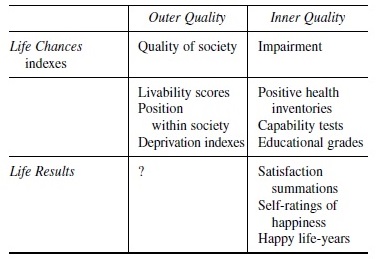
Measures of Livability
Environmental life chances are measured in two ways: (1) by the possibilities embodied in the environment as a whole and (2) by relative access to these opportunities. The former measures concern the livability of societies, such as nations or cities. These indicators are typically used in developmental policy. The latter are about the relative advantage or deprivations of persons in these contexts and are rooted mostly in the politics of redistribution.
Measures of livability of society focus on nations; an illustrative example is Estes’s (1984) Index of Social Progress. This measure involves aspects such as wealth of the nation, peace with neighbors, internal stability, and democracy. There are similar measures for quality of life in cities and regions. There are also livability counts for institutions such as army bases, prisons, hospitals for the mentally ill, and residences for the elderly.
Measures of relative deprivation focus on differences among citizens with regard to, for instance, income, work, and social contacts. Differences in the command of these resources are typically interpreted as differential access to scarce resources. All these measures work with a points system and summate scores based on different criteria in some way.
These inventories have the same limitations as multidimensional measures of better quality of life, but one problem specific to the measurement of livability is in the implicit theories behind the measure. The ingredients of these indexes are things believed to add to the livability of the environment, but these beliefs are not necessarily rooted in knowledge of what people really need. In this respect, measures of the livability of the social environment differ from the indicators used for the physical environment. On the basis of much research, we can now estimate fairly well how certain pollutants will affect illness and longevity. However, a similar evidence base is largely lacking for the livability of social environments, leaving a vacuum that is typically filled with ideological prepossession. As a result, there is some circularity in the use of these measures; although they are meant to show policymakers the way to the good life, they draw heavily on what policymakers believe to be a good life.
Measures of Life Ability
Different measures exist to assess “capabilities for living.” First, there is a rich tradition of health measurement in the healing professions.
Measures of health are, for the greater part, measures of negative health. There are various inventories of afflictions and functional limitations, several of which combine physical and mental impairment scores. Assessment is based on functional tests, expert ratings, and self-reports. There also are self-report inventories for positive health in the tradition of personality assessment (e.g., Ryff and Keyes 1995). This links up with a second tradition of capability measurement—that is, psychological “testing” for selection in education and at work.
As in the case of livability, these measures do not provide a complete estimate of life ability. Again, we meet the same fundamental limitations of completeness and aggregation. Unlike the case of livability, there is some validation testing in this field. Intelligence tests, in particular, are gauged by their predictive value for success at school and at work. Yet many of the other ability tests lack validation.
Measures for Utility of Life
There are many criteria for evaluating the usefulness of a life, of which only a few can be quantified. When evaluating the utility of a person’s life by the contribution that life makes to society, one aspect is good citizenship as measured by law abidance and voluntary work. Where the utility of a life is measured with its effect on the environment, consumption is a relevant aspect and there are several measures of “green living.” For some criteria, we have better information at the aggregate level. Wackernagel et al.’s (1999) ecological footprint measures how much land and water area is used to produce what we consume. Patent counts per country give an idea of the contribution to human progress and are part of Naroll’s (1984) index.
Measures of Appreciation of Life
Measurement of the subjective appraisal of life is relatively straightforward. Interviews are conducted through direct questioning, such as an interview or a questionnaire. Since the focus is on “how much” the respondent enjoys life rather than “why,” the qualitative interview method is limited in this field. Most assessments are self-reports in response to standard questions with fixed-response options.
Many of these measures concern specific appraisals, such as satisfaction with one’s sex life or perceived meaning of life. As in the case of life chances, these aspects cannot be meaningfully added in a whole, because satisfactions cannot be assessed exhaustively and differ in significance. Yet humans are also capable of overall appraisals. As noted earlier, we can estimate how well we feel generally and report on that. So encompassing measurement is possible in this quality quadrant.
There are various ways to ask people how much they enjoy their life as a whole. One way is to ask them repeatedly how much they enjoy it right now and to average the responses. This is called “experience sampling.” This method has many advantages, but it is expensive. The other way is to ask respondents to estimate how well they feel generally or to strike the balance of their life. This is common practice, and all the questions ever used for this purpose are stored in the Item Bank of the World Database of Happiness, a continuous register of scientific research on subjective enjoyment of life, kept at Erasmus University, Rotterdam in the Netherlands (http://www. worlddatabaseofhappiness.eur.nl).
There are doubts about the value of these self-reports, in particular about interpretation of questions, honesty of answers, and interpersonal comparability. Empirical studies, however, show reasonable validity and reliability. There are also qualms about comparability of average responses across cultures; it is claimed that questions are differently understood and that response bias differs systematically in countries. These objections have also been checked empirically and appeared to carry no weight. This literature is aptly summarized in Diener et al. (1999) and Schyns (2003).
Questions on enjoyment of life typically concern the current time. Most questions refer to happiness “these days” or “over the last year.” Obviously, the good life requires more than this, hence happiness must also be assessed over longer periods. In several contexts, we must know happiness over a lifetime or, better, how long people live happily. At the individual level, it is mostly difficult to assess how long and happily people live, because we can know that only when they are dead; however, at the population level, the average number of years lived happily can be estimated by combining average happiness with life expectancy. For details of this method, see Veenhoven (1996).
The magnitude of insight these quality-of-life measures provide is somewhat difficult to assess, simply because they measure too many different aspects of life. However, happiness provides a fairly inclusive output measure, especially when combined with life expectancy in happy lifeyears (HLY). For this reason, the next section summarizes the main results obtained with this indicator of quality of life.
Sociology of Happiness
Sociologists have studied happiness at two levels, at the macro level for comparing across nations and at the micro level for identifying differences within nations.
Happiness and Society
Comparative research on happiness started in the 1960s with Cantril’s (1965) global study on “the pattern of human concern.” Happiness is now a common item in international survey programs such as the World Values Survey. The standard question on life satisfaction is as follows:
Taking all together, how satisfied or dissatisfied are you currently with your life as a whole?

In the year 2005, comparable data were available for 90 nations. In the following, I offer some insights into what these data suggest about the quality of life in contemporary societies.
Level of Happiness in Nations
Most research has focused on average happiness, finding sizable and consistent differences across nations (see Diener and Suh 2000). As shown in Table 1, average happiness is above neutral in most countries, meaning that great happiness for a great number is possible. However, for Russia and for most former Soviet states, the average score is less than 5. Average happiness is also low in several African countries.
Table 1
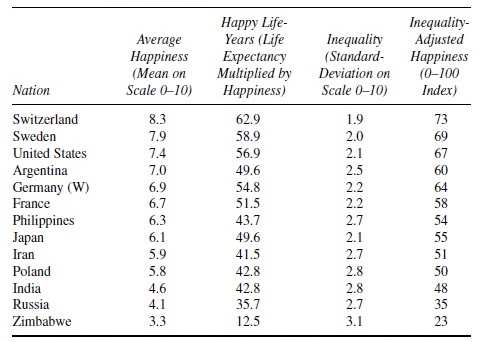
There is a system in these differences. People live more happily in rich nations than in poor ones and happiness is also higher in nations characterized by rule of law, freedom, good governance, and modernity. However, happiness is not related to everything deemed desirable. Income inequality in nations appears to be unrelated to average happiness, though it does accompany some inequality of happiness, as shown for 90 nations in the 1990s and presented in Table 2.
Table 2
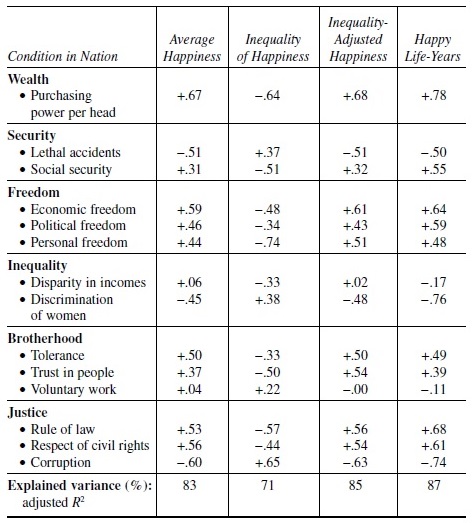
There is considerable interrelation between the societal characteristics. The most affluent nations are also the freest and the most modern. It is therefore difficult to estimate the effect of each of these variables separately. The correlations are much abated when level of income is controlled, and the correlation with social security turns negative. Still, with the exception of income inequality, sizable correlations remain. Whatever their relative contribution, these variables explain 83 percent of the differences in average happiness across nations.
Trend data on average happiness are available for the United States from 1945, for Japan from 1958, and for the first eight member states of the European Union (EU) from 1973. These data show that happiness rose somewhat in the United States and the EU but stagnated in Japan.
These findings do not fit the common theory that happiness depends on social comparison. Since people compare with compatriots in the first place, this would imply little difference across nations and no change over time. Nor do the findings fit the theory that happiness is a fixed mental trait; if so, there would not be such strong correlations with societal qualities or any change over time. The findings fit best with the livability theory of happiness, which holds that happiness depends on the gratification of innate human needs and that not all societies meet human needs equally well (Veenhoven 1995). Another noteworthy implication of the above findings is that modern society does not score as low in livability as much of problem-focused sociology suggests.
Inequality of Happiness in Nations
These data can also be used for assessing inequality of quality of life among citizens, using the standard deviation. The cross-national pattern of inequality of happiness resembles the pattern of differences in average happiness. Inequality of happiness is typically lower in the economically most developed nations of this time. Inequality is also lower in the freest nations and in the best-governed ones. Not surprisingly, inequality of happiness is higher in nations with relatively large income disparities.
Comparison over time shows a consistent decline in inequality of happiness in modern nations over the last decade. Inequality of happiness has declined even in Japan, where the average remained unchanged (Veenhoven 2005a). These findings contradict the common belief about new inequalities causing a growing split in modern society; rather, they suggest that the equalizing effects of modernization are still holding. The findings also show that inequality in quality of life is not merely a matter of distribution of scarce resources; it also depends on the general level of living and on freedom in society.
Inequality-Adjusted Happiness in Nations
The level and inequality of happiness in nations can be combined in an index of “inequality-adjusted happiness, which marries the utilitarian wish for greater happiness of a greater number with the egalitarian wish for fairness. The rank order of nations is again similar to that for average happiness, and the correlations with nation characteristics are also alike, which indicates that there is little conflict between utilitarian and egalitarian policies.
Happy Life-Years (HLYs)
People prefer a long and happy life to a short but happy life, and hence the length of life is taken into account by adjusting life expectancy for average happiness. This is analogous to the computation of disability-adjusted lifeyears in international health statistics (World Health Organization 2001). The HLY is computed by multiplying life expectancy with happiness expressed on a 0–1 scale. For example, if in a country, average life expectancy is 60 and average happiness on a 0–10 scale is 6, HLY is 60 × 0.6 = 36 years (Veenhoven 1996).
In Table 3, wide differences in HLY across nations are shown: almost 63 in Switzerland and less than 13 in Zimbabwe. The rank order is similar but not identical to average happiness. For instance, the Japanese are not too happy, but they live long and therefore rank higher on HLY than on happiness. The pattern of correlation with nation characteristics is also similar, but the explained variance of HLY is higher. HLY rose in all modern nations in the late twentieth century. Since 1973, Europeans have gained 4.3 HLY, the Japanese 4.4, and Americans 5.2. This means that the quality of life has improved in modern society, and this trend is likely to extend well into the twenty-first century (Veenhoven 2005b).
Table 3
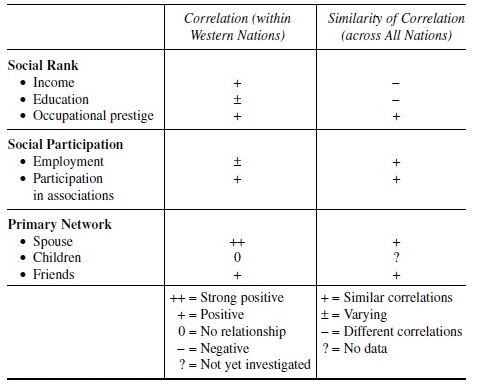
Happiness and Place in Society
Sociological studies of happiness have focused on differences within societies, looking primarily for links between happiness and social position. As summarized in Table 1, in Western societies, happiness is moderately related to social rank; the correlations tend to be stronger in non-Western nations. Happiness is also related to social participation, and this relation seems to be universal. Being linked into a primary network appears to be most crucial to happiness, especially being married. This relation is universal, but the presence of offspring is unrelated to happiness, at least in contemporary Western nations.
Few data exist for assessing trends in these correlations over time. Some basic findings suggest that in the United States, people of African descent have become somewhat happier (Thomas and Hughes 1986) and that happiness has also risen among the elderly (Witt et al. 1979). But there have been no systematic studies on shifts in the social conditions for happiness.
Prospects for the 21st Century
The main objective of sociological quality-of-life research is to guide public policy. In this area, multidimensional indexes are useful only for informing policymakers about how they are doing. As noted above, these measures typically reflect the current political agenda, and thus the scores inform policymakers how they have advanced along a chosen way. Happiness research also provides information about the way to choose, at least if “greater happiness for a greater number” is a policy aim. The idea that happiness should be promoted is the core of “utilitarian” moral philosophy (Bentham 1789), and the application of this idea in public policy is known as “rule utilitarianism.” This ideology is currently gaining ground, and consequently, there is a corresponding growth of interest in the implications of empirical research findings on happiness. For example, the British government commissioned research by Donovan et al. (2003), and several more reviews have been published recently (Frey and Stutzer 2002; Layard 2005; Veenhoven 2004). Since the evidence base is expanding rapidly, this literature is likely to continue to develop in the twenty-first century.
Quality-of-life research can also be used to assist individuals to make informed choices in their private life, such as taking up an occupation, having children, and the appropriate time to retire. Prediction of how much satisfaction will be derived from behavioral options is not very exact; for this reason, we can profit from the documented experiences of others. Such information would be particularly useful in the contemporary “multiple-choice society,” but current quality-of-life research does not meet this demand very well. The focus is still very much on given conditions of life, such as social class and personality, and not on things one can choose, such as early retirement. Moreover, most of the current research is in the form of correlations and does not provide information about causal effects. Yet another problem is that there is little specification by kinds of people, but this is required if one is to obtain tailored advice. This then defines yet another task for research on quality of life in the twentyfirst century.
Bibliography:
- Allardt, Eric. 1976. “Dimensions of Welfare in a Comparative Scandinavian Study.” Acta Sociologica 19:227–39.
- Andrews, Frank and Stephen Withey. 1976. Social Indicators of Well-Being: American Perceptions of Life Quality. New York: Plenum Press.
- Bentham, Jeremy. 1789. An Introduction into the Principles of Morals and Legislation. London, England: Payne.
- Campbell, Angus, Philip E. Converse, and Willard L. Rodgers. 1981. The Quality of American Life Perceptions, Evaluations and Satisfactions. New York: Russell Sage.
- Cantril, Hedly. 1965. The Pattern of Human Concerns. New Brunswick, NJ: Rutgers University Press.
- Cavan, Ruth S., Ernest W. Burgess, Herbert Goldhamer, and Robert J. Havighurst. 1949. Personal Adjustment in Old Age. Chicago, IL: Science Research.
- Clark, Patricia and Ann P. Bowling. 1990. “Quality of Everyday Life in Long-Stay Institutions for the Elderly. An Observational Study of Long-Stay Hospital and Nursing Home Care.” Social Science Medicine 30:1201–10.
- Diener, Ed, Richard E. Lucas, Heidi L. Smith, and Eunkook M. Suh. 1999. “Subjective Well-Being: Three Decades of Progress.” Psychological Bulletin 125:276–301.
- Diener, Ed and Eunkook M. Suh. 2000. Culture and Subjective Well-Being. Cambridge: MIT Press.
- Donovan, Nick, David Halpern, and Richard Sargeant. 2003. “Life Satisfaction: The State of Knowledge and Implications for Government.” Discussion Paper, Strategy Unit, UK Government, London, England.
- Estes, Richard. 1984. The Social Progress of Nations. New York: Praeger.
- Ferriss, Abbott L. 2004. “The Quality of Life Concept in Sociology.” American Sociologist 35:37–51.
- Frey, Bruno S. and Alois Stutzer. 2002. Happiness and Economics. Princeton, NJ: Princeton University Press.
- Gerson, Elihu M. 1976. “On Quality of Life.” American Sociological Review 41:793–806.
- Gurin, Gerald, Joseph Veroff, and Sheila Feld. 1960. Americans View Their Mental Health. A Nationwide Interview Survey. New York: Basic Books.
- Layard, Richard. 2005. Lessons from a New Science. New York: Penguin Books.
- Lehman, Anthony F. 1988. “A Quality of Life Interview for the Chronically Mentally Ill.” Evaluation and Program Planning 11:51–62.
- Naroll, Raoul. 1984. The Moral Order. London, England: Sage.
- Ogburn, William F. 1946. A Study of Rural Society. Cambridge, MA: Riverside Press.
- Ouelette-Kuntz, Helene. 1990. “A Pilot Study in the Use of the Quality of Life Interview Schedule.” Social Indicators Research 2:283–98.
- Ryff, Caroll D. and Corey L. Keyes. 1995. “The Structure of Psychological Well-Being Revisited.” Journal of Personality and Social Psychology 69:719–27.
- Schalock, Robert L. 1997. Quality of Life. 2, Application to Persons with Disabilities. Washington, DC: American Association on Mental Retardation.
- Schuessler, Karl F. and G. A. Fisher. 1985. “Quality of Life Research in Sociology.” Annual Review of Sociology 11:39–149.
- Schyns, Peggy. 2003. Income and Life Satisfaction. A CrossNational and Longitudinal Study. Delft, The Netherlands: Eburon.
- Spitzer, Walter O., Annette J. Dobson, Jane Hall, Esther Chesterman, John Levi, and Richard Shepherd. 1981. “Measuring the Quality of Life of Cancer Patients.” Journal of Chronic Disease 34:585–97.
- Thomas, Melvin E. and Michael Hughes. 1986. “The Continuing Significance of Race: A Study of Race, Class, and Quality of Life in America. 1972–1985.” American Sociological Review 51:830–41.
- United Nations Development Program. 1990. Human Development Report 1990. New York: Oxford University Press.
- VanPraag, Bernard M. 2004. Happiness Quantified. A Satisfaction Calculus Approach. Oxford, England: Oxford University Press.
- Veenhoven, Ruut. 1995. “The Cross-National Pattern of Happiness. Tests of Predictions Implied in Three Theories of Happiness.” Social Indicators Research 34:33–68.
- Veenhoven, Ruut. 1996. “Happy Life-Expectancy.” Social Indicators Research 39:1–58.
- Veenhoven, Ruut. 2004. “Happiness as a Public Policy Aim: The Greatest Happiness Principle.” Pp. 658–78 in Positive Psychology in Practice, edited by P. A. Linley and S. Joseph. London, England: Wiley.
- Veenhoven, Ruut. 2005a. “Inequality of Happiness in Nations.” Journal of Happiness Studies (special issue) 6:351–55.
- Veenhoven, Ruut. 2005b. “Is Life Getting Better? How Long and Happy People Live in Modern Society.” European Psychologist (special issue) 10:330–43.
- Wackernagel, Mathis, Larry Onisto, Patricia Bello, Aleandro Callejas Linares, Ina S. Lopez-Falfan, Jezus Mendez Garcia, Anna I. Suarez Guerrero, and Ma. Guadalupe Suarez Guerrero. 1999. “National Natural Capital Accounting with the Ecological Footprint Concept.” Ecological Economics 29:375–90.
- Ware, John E., Jr. 1996. “The SF-36 Health Survey.” Pp. 337–45 in Quality of Life and Pharmaco-Economics in Clinical Trials, edited by B. Spilker. Philadelphia, PA: LippincottRaven.
- Witt, David D., Evans W. Curry, George D. Lowe, and Charles W. Peek. 1979. “The Changing Association between Age and Happiness: Emerging Trend or Methodological Artifact?” Social Forces 58:1302–1307.
- World Health Organization. 2001. The World Health Report 2000. Geneva, Switzerland: WHO.




